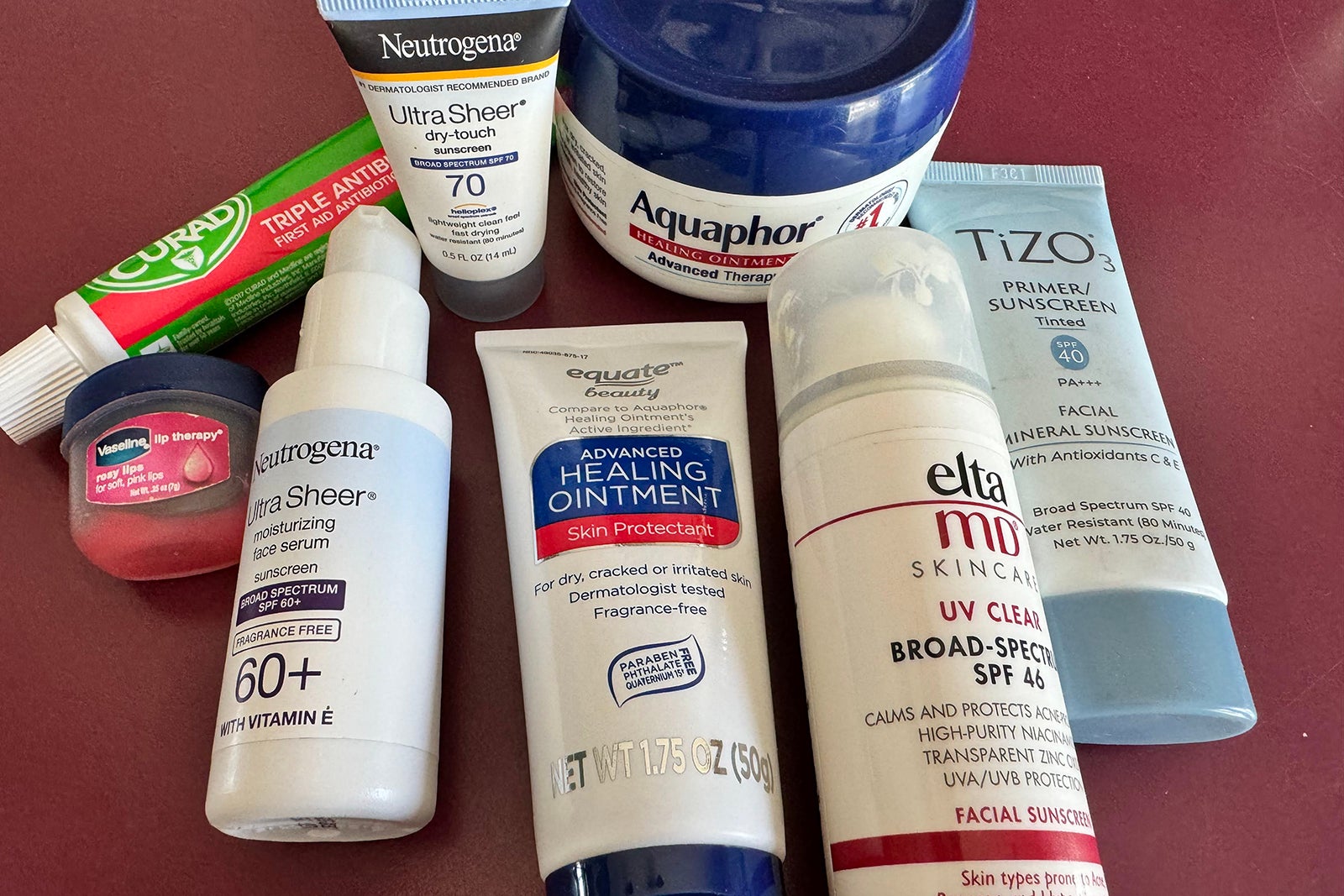
If you’re like most cruisers, you strive to follow cruise line rules about what to pack and what not to pack. Nobody really wants to have their stuff confiscated or to have to visit the “naughty room” in the bowels of the ship to claim their luggage because security discovered an illicit item.
So, even though I’m an expert cruiser, I diligently read through the “what not to pack” list of my cruise line’s guest ticket booklet before packing for my recent cruise.
I expected to find the usual list of banned items, including drugs, weapons, candles, irons and hot plates. Much to my surprise, though, the only things listed were chemicals — including chemicals found in the sunscreens and cosmetics I planned to pack.
For cruise news, reviews and tips, sign up for TPG’s cruise newsletter.
The more I studied the list, the more curious I became. I fully understand that many destinations have banned chemical sunscreens in favor of those proven to be less harmful to reefs. But this list included not only the banned chemicals, but titanium dioxide, one of the ingredients most commonly associated with so-called “reef-safe” sunscreens (though some recent studies claim that titanium dioxide might be more harmful than previously thought).
Even more surprising was the first thing on the list: petrolatum. Wait, I can’t pack Vaseline for my lips? I started checking the labels on everything in my cosmetic bag. Would they confiscate my moisturizer that has an SPF of 40 and contains two of the banned chemicals?
Caught between my desire to save the oceans and save my skin from dryness, burns and cancer, I needed a new packing plan. Here’s what I did and how you should approach recommendations like these on your next sailing.
I checked the actual cruise line prohibitions
Once I recovered from my initial panic, I started my investigation. Were the items on the “what not to pack” list suggestions, or were they actual prohibitions?
The phrase in the ticket booklet used the word “recommend.” That was good, but I referred back to the guest terms and conditions to cross-check the list of items specifically prohibited. No cosmetic or sunscreen chemicals and no petrolatum appeared on that list. Whew!

Daily Newsletter
Reward your inbox with the TPG Daily newsletter
Join over 700,000 readers for breaking news, in-depth guides and exclusive deals from TPG’s experts
If they weren’t technically banned, I assumed they wouldn’t be confiscated. Right?
I educated myself about sunscreen (and cosmetic) ingredients
Many destinations have banned chemical-based sunscreens because they are proven to be harmful to the reefs. To make sure I knew which chemicals were the most harmful and definitely ones to avoid, I decided to research the chemicals on my cruise line’s “do not pack” list.
Current chemical bans by destinations are a mixed bag from four main chemical culprits: oxybenzone, avobenzone, octocrylene and octinoxate. Rather than worry about which chemical is banned where, you should aim to skip all of them when you shop for sunscreens for your cruise.
In addition to sunscreens, the banned chemicals are likely to be found in any cosmetic product with an SPF (Sun Protection Factor) on its label, including lip balms and lipsticks, moisturizers, foundations, primers, concealers and serums. Even in the tiny amounts of these products you are likely to use, they would still harm the reefs.
That holds true even if you don’t plan to get in the ocean. Water that goes down any drain on the ship — in hand sinks, showers, hot tubs and pools — could still end up in the ocean with little to no filtration, depending on each ship’s technology. It’s considered “gray water,” not sewage, and thus allowed to be discharged in the open ocean (not in ports). These matters are governed by the International Maritime Organization’s International Convention for the Prevention of Pollution from Ships, commonly known as MARPOL, to which all cruise lines adhere, as well as bylaws in individual countries governing their own waters.
The current consensus is that mineral sunscreens are far less likely to cause harm than chemical-based versions. Minerals are naturally occurring and don’t dissolve in seawater, making them presumably safer for both marine life and humans.
Zinc oxide has been used as a sunblock for decades. Today’s technology has made the zinc particles smaller and the products more transparent than they used to be.
But what about titanium dioxide? I found it listed on more than half of the mineral-based products I checked, yet my cruise line listed it as something I should not bring on board. A bit of research turned up that titanium dioxide is banned as a food additive in the European Union but not in the U.S. I found no official bans on sunscreens or cosmetics using titanium dioxide.
And the cruise line’s recommendation not to bring petrolatum? My Vaseline and I are not easily parted. During my research, I discovered that it appeared my cruise line had taken its recommendations almost word for word from a Hawaii tourism website stating that petrolatum, also known as mineral oil, takes a long time to biodegrade and is harmful or even fatal to wildlife. I found no official ban by any government on products containing petrolatum.
I packed the contraband — for research purposes
Because it was unclear how seriously the cruise line was taking its own recommendations, I did pack some sunscreen and cosmetics containing chemicals on the cruise line’s list of products to avoid. I crossed my fingers that they would not be confiscated; if they were, I’d have to purchase expensive, all-new products on board.
I took four different products containing petrolatum — both in my carry-on and in my checked luggage. I made sure every item was highly visible should an inspection take place.
In my case, not one item was confiscated or questioned. No Vaseline-sniffing dog barked me out as I waited in the security line.
I followed the guidelines anyway
Part of the reason I took this situation so seriously is that I have had surgery for skin cancer three times in the past eight months, so I am fastidious about applying sunscreen. I’m also a diver, so I’m strongly in favor of protecting the reefs. Even though I was skeptical about certain things on the “do not pack list,” I still searched for products that might accommodate the recommendations and work well for a week in the Caribbean sun on my cruise.
I found popular sunscreen brands with reasonable price tags that had none of the four banned chemicals and only zinc oxide as an active ingredient — even in an inland town in Central Texas. Coppertone Pure & Simple and Sport Mineral both fit the bill. Choices were a bit better in Fort Lauderdale where my ship departed from. Eucerin Sensitive Mineral and Aveeno Baby Zinc Oxide sunscreen would have both worked.
I stuck with the five-ingredient Badger Sport Mineral I had ordered online, primarily because it used beeswax as a base rather than petrolatum, and anything with fewer ingredients seems like a safer bet when we’re talking about the ocean. I was quite happy with it for all full-sun activities during the cruise, including boat rides, swimming and snorkeling.
As for cosmetics, I found that eliminating the titanium dioxide was almost impossible. For days on board when I needed sun-protective makeup on my face and not just sunscreen, I opted for Tizo3 tinted primer and L’Oreal True Match mineral powder — both of which relied on only titanium dioxide.
To reduce the amount of titanium dioxide going down the drain and into the ocean, I used Burt’s Bees Purifying white tea facial towelettes. I reasoned that tossing these upcycled cotton, compostable towelettes in the ship’s garbage was a smidge better than washing anything extra almost directly into the ocean.
To keep my lips from drying out without dipping into the Vaseline I smuggled on board, I opted for Burt’s Bees Tinted Lip Balm supplemented with Alba Botanica Un-petroleum Multi-purpose Jelly in a tube. For sun protection in ports and on board, I used CoTZ SPF Mineral Lip Balm Tinted, which has a combination of zinc and titanium mineral active ingredients.
While I might have gone a bit overboard (pun intended), I suffered no sunburn and, to the best of my knowledge, no reefs or reef creatures were harmed by the products I chose to use. I found mineral sunscreens and cosmetics were relatively easy to shop for and there are alternatives for petrolatum products.
The real bottom line is that even if you feel like your cruise line might be a bit more restrictive than necessary, as a rule, these companies have a vested interest in protecting the world’s oceans. With a bit of extra effort, it is possible to follow their recommendations and feel good about your choices.
Planning a cruise? Start with these stories:





